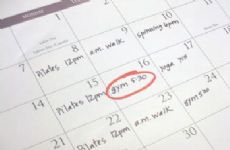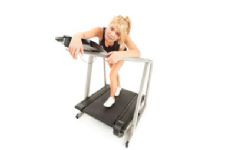|
Days get shorter, temperatures dip, and the leaves fall from the trees. Fall brings many changes, but that doesn't mean your workouts have to suffer. Instead of letting these autumnal changes bring upon excuses for exercising, look for the opportunity in each of them to renew and revamp your workout routine. To make your workouts work with the season change rather than against it, try one of these excuse-proof tactics. Change it up. No matter what the season, it's important to switch up your workouts. Don't let your body expect and adapt to the same mode of exercise. So, the change of seasons is an excellent time to "trick" the body and try some new twists to your workouts. Listen for cues from your body to tell if it's time for a workout changeup: are you bored, are your workouts inconsistent, and are you not motivated? If so, it's time to switch things up. If you've been running all summer long, try adding in some strength training. If you've been a cardio machine queen, try some new group classes instead or personal training sessions instead. You could also add in different kinds of workouts, like metabolic work or tabata workouts. Join a team or a club. Find an activity or sport you enjoy or maybe have always wanted to try and sign up for it. Whether it's a recreational volleyball team or a bowling league, a group will hold you accountable and keep you motivated to get out of the house and exercise when the colder weather might make you want to hibernate. Additionally, many running clubs often start training for a race in the fall. Find a local running club to join using the Road Runners' Club of America's (RRCA) online hub. (Start training for SparkPeople's Virtual Trick or Treat Trot 5K!) Be seen. Working out before sunrise (or after sunset) can be a very serene experience. There are fewer people out, and it's less noisy. It's just you and the road. However, if you do workout in the dark thanks to shorter days, stay safe by wearing reflective gear. Most athletic shoes already come with reflective material, but to ensure you can be seen by oncoming cars, wear a reflective vest, shirt, or reflective tape attached to your workout gear. (Get more Winter Workout Safety Tips, 13 Cold Weather Exercise Tips, and Safety Tips for Exercising in the Dark) I had a close call with this one. Once I was out running in the evening on a snowy winter night without reflective gear, and a man in a truck actually pulled over to yell at me because he couldn't see me and almost hit me. I was flustered at the time, but quickly realized he was completely right. I never forgot again! Layer up. Make sure to check the forecast and dress appropriately. Wearing layers works great because you can shed them as you warm up. However, keep those layers handy; sweating in cooler temps can be dangerous. Your body temperature is more likely to fluctuate when exercising in cooler weather. Again, get advice from a runners' club about the best type of clothing and wind chill factors for outdoor activities in your area. (Cold Weather Workout Gear and Gear Up: Coach Nicole's Must-Have Accessory for Cold-Weather Workouts) Stay hydrated. If you choose to keep your training outdoors, be mindful to drink water despite the cooler temps. Even if you're not sweating as much as you would be in the summer, you can still become dehydrated. Perspiration isn't the only way to lose body fluids. Huffing and puffing can cause loss of body fluids as well since we lose water and electrolytes through our breath. Paige is an ACE-certified personal trainer, boot camp instructor, and project planner for IT. She maintains the blog, Running Around Normal, where she writes about fitness, health, food, and her daily life. Helping clients get fit and healthy, Paige also strives to follow her own advice, and that includes getting advice and new ideas from other experts. Does your workout routine change with the seasons? How? |
Related EntriesMore From SparkPeople
|




















.jpg)
